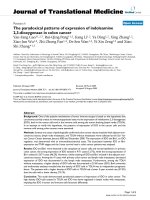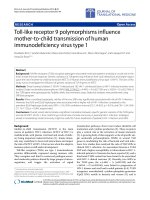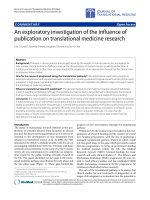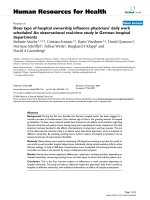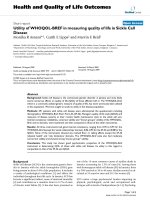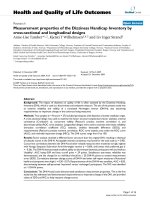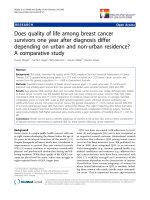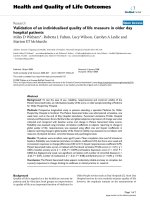báo cáo hóa học: " Does angiotensin-1 converting enzyme genotype influence motor or cognitive development after pre-term birth?" docx
Bạn đang xem bản rút gọn của tài liệu. Xem và tải ngay bản đầy đủ của tài liệu tại đây (237.56 KB, 6 trang )
BioMed Central
Page 1 of 6
(page number not for citation purposes)
Journal of Neuroinflammation
Open Access
Research
Does angiotensin-1 converting enzyme genotype influence motor
or cognitive development after pre-term birth?
David R Harding*
1
, Sukhbir Dhamrait
2
, David Devadason
1
,
Steve E Humphries
2
, Andrew Whitelaw
3
, Neil Marlow
4
and
Hugh E Montgomery
2
Address:
1
Neonatal Intensive Care Unit, St. Michael's Hospital, Bristol, UK,
2
Division of Cardiovascular Genetics, University College London,
London, UK,
3
University of Bristol Medical School, Southmead Hospital, Bristol, UK and
4
School of Human Development, University of
Nottingham, Nottingham, UK
Email: David R Harding* - ; Sukhbir Dhamrait - ;
David Devadason - ; Steve E Humphries - ;
Andrew Whitelaw - ; Neil Marlow - ;
Hugh E Montgomery -
* Corresponding author
Abstract
Background: Raised activity of the renin-angiotensin system (RAS) may both amplify inflammatory
and free radical responses and decrease tissue metabolic efficiency and thus enhance cerebral injury
in the preterm infant. The angiotensin-converting enzyme (ACE) DD genotype is associated with
raised ACE and RAS activity as well as potentially adverse stimuli such as inflammation. The DD
genotype has been associated with neurological impairments in the elderly, and thus may be also
associated with poorer motor or cognitive development amongst children born preterm
prematurely.
Methods: The association of DD genotype with developmental progress amongst 176 Caucasian
children born at less than 33 weeks gestation (median birthweight 1475 g, range 645–2480 g;
gestation 30 weeks, range 22–32; 108 male) was examined at 2 and 5 1/2 years of age. Measured
neuro-cognitive outcomes were cranial ultrasound abnormalities, cerebral palsy, disability, Griffiths
Developmental Quotient [DQ] at 2 yrs, and General Cognitive Ability [British Ability Scales-11]
and motor performance [ABC Movement], both performed at 5 1/2 yrs. All outcomes were
correlated with ACE genotype.
Results: The DD genotype was not associated with lower developmental quotients even after
accounting for important social variables.
Conclusion: These data do not support either a role for ACE in the development of cognitive or
motor function in surviving infants born preterm or inhibition of ACE as a neuroprotective therapy.
Background
Delight over recent survival gains for the very premature
infant has been tempered by the frequent presence of cer-
ebral injury and developmental impairment. One quarter
Published: 22 February 2005
Journal of Neuroinflammation 2005, 2:6 doi:10.1186/1742-2094-2-6
Received: 22 November 2004
Accepted: 22 February 2005
This article is available from: />© 2005 Harding et al; licensee BioMed Central Ltd.
This is an Open Access article distributed under the terms of the Creative Commons Attribution License ( />),
which permits unrestricted use, distribution, and reproduction in any medium, provided the original work is properly cited.
Journal of Neuroinflammation 2005, 2:6 />Page 2 of 6
(page number not for citation purposes)
of those born before 26 weeks postmenstrual age (at least
11 weeks premature) show evidence of severe cerebral
injury including cognitive dysfunction by 30 months of
age [1]. Preterm children without any disability remain at
risk of a range of motor, cognitive, behavioural and psy-
chological deficits during childhood even if not born so
close to the margin of viability [2]. To date, the patho-
physiological processes leading to such impairment
remain largely occult. In particular, cerebral imaging has
failed to identify structural correlates of impaired higher
function [3] although imaging can predict many cases of
motor abnormality (such as cerebral palsy) due to the
presence of periventricular white matter injury [4].
Three factors seem to play important roles in the aetiology
of preterm cerebral injury. Firstly, exposure to inflamma-
tory stimuli is associated with white matter injury and cer-
ebral palsy in the preterm [5]. Secondly, reduced glucose
and oxygen delivery to the developing brain (hypoxia-
ischaemia: local cerebral or systemic) may cause excito-
toxic neurotransmitter release followed by neuronal death
[6]. Thirdly, free-radicals may damage the oligodendro-
cytes of white matter of the preterm brain [6]. Damage to
the primitive white matter prevents the normal formation
of grey matter connections which may influence cognitive
development in childhood [7].
Candidate systems that might influence motor or cogni-
tive outcome after premature birth are likely to be those
which affect these responses. The human renin-angi-
otensin systems may be such a system. Angiotensin con-
verting enzyme (ACE), a key component of the circulating
(or endocrine) renin-angiotensin system (RAS), cleaves
angiotensin I to yield the potent vasoconstrictor angi-
otensin II. In addition, ACE degrades vasodilator kinins.
In these ways, endocrine RAS plays an important role in
circulatory homeostasis. However, local RAS also exist in
diverse human tissues including lung, myocardium, vas-
culature, lymphocyte and brain tissue. These are powerful
regulators of mitochondrial respiration and whole-cell
metabolism [8] and exert profound effects on whole-
human metabolism and metabolic efficiency: elevated
ACE may impair cellular aerobic metabolism [9]. RAS also
plays a key role in the regulation of tissue inflammatory
responses; ACE, through generation of angiotensin II,
stimulates the synthesis of pro-inflammatory cytokines,
including IL-6 which itself is thought to exert major neu-
rocytotoxic effects with the genesis of functionally signifi-
cant lesions in the developing preterm brain [5]. It has
also been noted that the inhibition of RAS may reduce the
effects of excitotoxic neurotransmitters and free radicals
[10]. It is possible therefore that enhanced ACE activity
may adversely influence the development of the child
born prematurely.
A common variant of the human ACE gene provides a tool
to determine if ACE activity does influence developmental
progress after preterm birth. The presence (insertion, or 'I'
allele) rather than the absence (deletion, or 'D' allele) of a
284-base-pair fragment in the human ACE gene is associ-
ated with lower ACE activity in organs including both cir-
culating inflammatory cells [11] and the circulation itself
[12]. Given the likely causal association of pro-inflamma-
tory responses, ischaemic-hypoxia, excitotoxic neuro-
transmitters, and free radical attack with impaired neuro-
outcome; and given the potential role of increased RAS
activity in amplifying these effects, we might expect the
DD genotype (encoding raised ACE activity) to be associ-
ated with poorer neuro-developmental progress after pre-
tem birth. Comparable findings have been described with
respect to the deterioration of cognitive function in the
elderly by some authors [13-15]. We have tested this
hypothesis by studying the association of the ACE I/D pol-
ymorphism with measures of neuro-developmental
progress at 2 and 5 1/2 years of age in children who had
participated in a neuro-developmental outcome study
(The Avon Premature Infant Project, APIP [16]). All the
patients were born at less than 33 weeks postmenstrual
age (normal gestation is 37–40 weeks).
Methods
Patients
The study was approved by the ethical committees of
Southmead Hospital and United Bristol Health Care
Trust. Parental consent was obtained for participation in
neurodevelopmental follow-up [16] (see below). Consent
was not required for the genetic component of this study
as all personal information was held separately from the
genetic information and patients were identified only by
study codes.
All children were born at 32 weeks gestation or less,
between December 1990 and July 1993 at Southmead
Hospital or St. Michael's Hospital, Bristol. All had partici-
pated in the Avon Premature Infant Project (APIP) [16].
Briefly, this was a randomised controlled trial in which
developmental support (Portage) or supportive counsel-
ling (parental adviser), each started at discharge and con-
tinued for up to 2 years, were found to confer some
measurable (3–4 DQ points (below)) but clinically insig-
nificant benefit to development at 2 years of age, when
given in addition to appropriate primary care and com-
munity support, after adjusting for social variables.
Neuro-developmental outcome
The Griffiths Mental Development Scales, used to assess
motor and cognitive performance, was performed at 2
years corrected age [17]. The Griffiths scales comprise five
subscales, including personal and social, hearing and
speech, locomotor, eye hand co-ordination and
Journal of Neuroinflammation 2005, 2:6 />Page 3 of 6
(page number not for citation purposes)
performance domains, from which is derived an overall
developmental quotient (DQ). A lower Griffiths DQ
reflects a poorer neuro-developmental performance, with
a difference DQ of five points being clinically apparent.
DQ was standardised originally to a mean of 100, with a
standard deviation of 15, but secular drifts in population
scores have resulted in a higher population mean. Thus
for severe disability a score of 70 (-2 standard deviations
(sd)) would indicate severe disability. Cognitive develop-
mental progress at 5.5 years of age was assessed using the
British Ability Scales [18]. The BAS-II was standardised in
the early 1990s and was used to compute general cogni-
tive ability (GCA) together with visuospatial, verbal and
non-verbal subscales. The GCA is a developmental quo-
tient, equivalent to an IQ estimate, normalised at 100 (sd
+/- 15) in which a lower score again indicates poorer con-
ceptual ability. The Movement ABC scales were used to
assess manual dexterity, ball skills, and balance over ten
tests at 5 1/2 years of age. Scores of each component are
summed to produce a composite score ranging from 0–
40, with high scores indicating a more impaired motor
skills and 0 indicating normal skills.
A psychologist performed the Griffiths Scales of Mental
Development and a second psychologist performed the
British Ability Scales (second edition) (BAS). The ABC
Movement tests were performed by a trained research
nurse. All assessments were blind to the child's neonatal
course and subsequent progress.
ACE genotyping
DNA was extracted from the Guthrie card blood spots
(newborn metabolic screening cards). ACE genotype was
determined using 3-primer PCR amplification [9]. Primer
ratios corresponded to 50 pmol of an I-specific oligonu-
cleotide in a 20-υl reaction volume. The PCR was per-
formed using Taq polymeraase yielding amplification
products of 84 bp for the D allele, and 65 bp for the I
allele. Amplification products were visualised using a
7.5% polyacrylamide gel stained with ethidium bromide.
Genotyping was performed by staff blind to all clinical
data.
Study Size
An estimate of sample size suggested that 144 patients
would be needed for this study. The assumptions made
for this calculation were that DD genotype infants had a
mean DQ of 92.5 (1/2 SD below the norm) compared to
a mean DQ of 100 in the ID+II group, assumed typical
genotype distributions, and a significance of 0.05 with
80% power.
Statistical analysis
Data were stored in SPPS v9.0 for Windows. Lymphocyte
[11] and tissue ACE [12] activity is primarily raised in DD
genotype when compared to either ID or II genotype, and
so data for those of DD genotype were compared to those
from I-allele carriers. Categorical data were analysed by
Chi square and continuous data by Student's T Test if nor-
mally distributed or Mann-Whitney U test as appropriate.
Results
Guthrie cards were located for 230 of 308 children. After
exclusion of non-Caucasians and, at random, 1 child of
any identical twin pairs (based on genotypes and gender)
176 babies with ACE genotype formed the study popula-
tion (median birthweight 1475 g, range 645–2480 g; ges-
tation 30 weeks, range 22–32) with follow-up data at 2
years. 122 of these also had follow-up at 5 1/2 years. The
ACE genotype distribution was 49 [27.8%] DD, 73
Table 1: Perinatal and social factors
DD Genotype (n = 49) ID/II Genotype (n = 127)
No maternal antenatal corticosteroids 44 (80%) 112 (81%)
No. of children from twin pregnancy* 4 (8%) 27 (21%)
Male 32 (65%) 76 (60%)
Gestation, weeks (± SEM) 29.7 (± 0.3) 30.0 (± 0.2)
Birth weight, g (± SEM) 1453 (± 56) 1461 (± 34)
Portage, parent adviser 17 (31%), 19 (35%) 46 (33%), 42 (30%)
Severe intraventricular haemorrhage 5 (11%) 7 (6%)
White matter injury 7 (14%) 14 (11%)
Maternal age (± SEM) 27.2 (± 0.8) 27.4 (± 0.8)
Manual occupation 28 (57%) 76 (60%)
Maternal car use 30 (61%) 75 (60%)
Mother educated beyond 16 yrs. 17 (35%) 48 (38%)
*p = 0.047 (Fisher's Exact Probability Test)
Continuous data is shown as mean (± standard error of mean).
Journal of Neuroinflammation 2005, 2:6 />Page 4 of 6
(page number not for citation purposes)
[41.5%] ID, 54 [30.7%] II, demonstrated Hardy-Weinberg
equilibrium, and was similar to that observed in the new-
born term population from the same region of the UK
(203 [24.1%] DD, 433 [51.5%] ID, 205 [24.4%) II). Base-
line characteristics were independent of genotype, except
that fewer individuals of DD genotype were from twin
births (p = 0.047) (table 1). There was no association
between markers of neonatal cerebral injury: severe intra-
ventricular haemorrrhage or white matter injury (table 1).
There was no association with the presence of any disabil-
ity at 2 years of age (DD 17% vs ID/II 15%, p = 0.65).
Measures of developmental cognitive and motor outcome
were entirely independent of genotype (table 2). The find-
ings were unchanged after post hoc subgroup analysis of
singletons, infants with normal cranial scans, amongst
children without disability and after adjusting for poten-
tial influential variables (including twin birth) using mul-
tiple regression (data not shown).
Discussion
After a search of Embase and Medline we believe that this
study is the first to attempt to dissect out the contribution
of genetic variation in the ACE gene to developmental
progress after pre-term delivery. Despite much physiolog-
ical and biochemical evidence to support our hypothesis,
we found that ACE DD genotype was not associated with
adverse long term developmental outcome in infants of <
33 weeks gestation in this study.
These data are perhaps at variance with previous studies of
Alzheimer's disease, age-associated memory impairment
and vascular dementia, all of which have implicated the
ACE D allele in having a role in mental decline [13-15].
However this is not a universal finding. Furthermore
although ACE inhibitors appear to reduce inflammatory
responses, ischaemic effects, and excitotoxic and free rad-
ical induced injury [10], angiotensin II does not (indeed
angiotensin II may actually enhance ischaemic and excito-
toxic neural injury via the AT2 receptor). In addition, both
captopril and losartan (RAS inhibitors) appear to improve
cognitive performance in mice [19] and humans [20]. It
should be noted however that little is known about the
ontogeny of the RAS in the human foetus. Certainly RAS
(and angiotensin II receptors in particular) play a role in
blood-brain barrier and central nervous system develop-
ment in mice, and alterations in RAS receptor expression
over foetal and neonatal life are recognised. It is thus pos-
sible that developmentally regulated patterns of AT1
receptor expression might offer some level of protection
against the potentially detrimental effects of ACE-medi-
ated angiotensin II synthesis.
Although there may be similar molecular pathways that
effect cerebral injury in the preterm infant and the elderly,
ontological differences in the expression of genes
involved in predisposition to neural injury are well
described. In particular reactive production of nitric oxide
may be enhanced in the elderly and the ability to protect
the brain from oxidants may be reduced in the elderly
(22). Thus the effect of any one polymorphism, with a rel-
atively minor effect, may be swamped in the newborn
infant by other protective mechanisms.
Table 2: ACE genotype and developmental performance at 2 and 5 1/2 years of age. Data shown is mean (± SEM).
Developmental tests DQ for DD DQ for ID/II p
Griffith DQ at 2 years 96.2 (3.1) 96.3 (1.3) 0.95
Locomotor subscale 92.7 (2.7) 92.4 (1.3) 0.92
Personal & social subscale 101.9 (3.0) 101.0 (1.6) 0.80
Hearing and speech subscale 92.9 (4.1) 94.0 (2.1) 0.80
Eye hand co-ordination subscale 90.8 (3.1) 92.8 (1.2) 0.46
Performance subscale 102.2 (4.3) 101.3 (1.6) 0.79
Griffith DQ at 2 years (adjusted for social variables) 100.0 (0.9) 99.3 (0.6) 0.43
ABC Movement summative score 8.1 (1.8) 8.0 (0.9) 0.97
GCA at 5 1/2 years 99.2 (3.4) 100.2 (2.0) 0.80
Verbal ability subscale 98.0 (4.0) 103.2 (1.7) 0.22
Pictoral ability subscale 99.9 (3.3) 98.7 (1.7) 0.99
Spatial ability subscale 98.4 (3.3) 97.3 (1.9) 0.67
Journal of Neuroinflammation 2005, 2:6 />Page 5 of 6
(page number not for citation purposes)
The lack of any association between ACE genotype and
scores of developmental progress was also surprising
because we have demonstrated an association between
DD genotype and markers of poor cardio-respiratory
instability in the perinatal period in this patient group
[21]. This association (between genotype and worse early
cardio-respiratory status) could predispose to death,
which would in turn weaken any association (if it exists)
between DD genotype and worse developmental quo-
tients. It is of course possible that our sample size was
insufficient to demonstrate any association with ACE gen-
otype and developmental progress. However, similar-
sized studies have been sufficient to demonstrate an asso-
ciation between ACE D allele and cognitive decline in the
elderly [13-15], and power calculations suggested we had
enough patients to demonstrate at least a trend. If an
undetected genotype-association does exist such an effect
is weak.
Conclusion
We cannot support an association of ACE genotype with
cognitive or motor development in survivors born pre-
term or, thus, the use of RAS inhibition as a neuroprotec-
tive agent in the preterm. Given the current lack of
understanding of the mechanisms leading to cerebral
injury and subsequent impairment – particularly of
higher function – in such patients, further genetic associ-
ation studies of other candidate genes are warranted.
List of abbreviations used
ACE, angiotensin-1 converting enzyme; DQ developmen-
tal quotient, BAS, British ability scales (second edition);
GCA, general cognitive ability; RAS, renin angiotensin sys-
tem; PCR, polymerase chain rection.
Competing interests
The author(s) declare that they have no competing
interests.
Authors' contributions
DH, HM, AW, NM conceived the study and its design and
wrote the manuscript. DH, DD and SD performed data
collection, DNA extraction and PCR and participated in
analysis of the data with SH and HM. NM reviewed all cra-
nial imaging. All authors participated in the writing of the
manuscript and approved the final manuscript.
Acknowledgements
The developmental assessments were performed by Dr Margaret Robinson
(Griffiths Assessments), Pat Anderson (BAS-II) and Wendy Ring (Move-
ment ABC). This research was supported by awards from The Southmead
Hospital Research Foundation to AW and DH. The British Heart Founda-
tion (grant numbers RG200015, SP98003, FS01XXX) SHE, HM, and SD.
The original APIP study was supported by Action Research (Grant to NM).
References
1. Wood NS, Marlow N, Costeloe K, Gibson AT, Wilkinson AR: Neu-
rologic and developmental disability after extremely pre-
term birth. EPICure Study Group. N Engl J Med 2000,
343:378-384.
2. Botting N, Powls A, Cooke RW, Marlow N: Cognitive and educa-
tional outcome of very-low-birthweight children in early
adolescence. Dev Med Child Neurol 1998, 40:652-660.
3. Stewart AL, Rifkin L, Amess PN, Kirkbride V, Townsend JP, Miller
DH, Lewis SW, Kingsley DP, Moseley IF, Foster O, Murray RM:
Brainstructure and neurocognitive and behavioural function
in adolescents who were born very preterm. Lancet 1999,
353:1653-1657.
4. de Vries LS, Eken P, Groenendaal F, van Haastert IC, Meiners LC:
Correlation between the degree of periventricular leukoma-
lacia diagnosed using cranial ultrasound and MRI later in
infancy in children with cerebral palsy. Neuropediatrics 1993,
24:263-268.
5. Yoon BH, Jun JK, Romero R, Park KH, Gomez R, Choi JH, Kim IO:
Amniotic fluid inflammatory cytokines (interleukin-6, inter-
leukin-1 beta, and tumor necrosis factor-a), neonatal brain
white matter lesions and cerebral palsy. Am J Obstet Gynecol
1997, 177:19-26.
6. Inder TE, Volpe JJ: Mechanisms of perinatal brain injury. Semin
Neonatol 2000, 5:3-16.
7. Marin-Padilla M: Developmental neuropathology and impact of
perinatal brain damage. II: white matter lesions of the
neocortex. J Neuropathol Exp Neurol 1997, 56:219-235.
8. Loke KE, Laycock SK, Mital S, Wolin MS, Bernstein R, Oz M,
Addonizio L, Kaley G, Hintze TH: Nitric oxide modulates mito-
chondrial respiration in failing human heart. Circulation 1999,
100:1291-1297.
9. Williams AG, Rayson MP, Jubb M, World M, Woods DR, Hayward M,
Martin J, Humphries SE, Montgomery HE: The ACE gene and mus-
cle performance. Nature 2000, 403:614.
10. Ravati A, Junker V, Koukei M, Ahlmeyer B, Culmsee C, Krielstein J:
Enalapril and moexipril protect from free radical-induced
neuronal damage in vitro and reduce ischemic brain injury in
mice and rats. Eur J Pharmacol 1999, 373:21-33.
11. Costerousse O, Allegrini J, Lopez M, Alhenc-Gelas F: Angiotensin I-
converting enzyme in human circulating mononuclear cells:
genetic polymorphism of expression in T-lymphocytes. Bio-
chem J 1993, 290:33-40.
12. Rigat B, Hubert C, Alhen-Gelas F, Cambien F, Corvol P, Soubrier F:
An insertion deletion polymorphism in the angiotensin 1-
converting enzyme gene accounting for half the variance of
serum enzyme levels. J Clin Invest 1990, 86:1343-1346.
13. Bartres-Faz D, Junque C, Clemente IC, Lopez-Alomar A, Valveny N,
Lopez-Guillen A, Lopez T, Cubells MJ, Moral P: Angiotensin I con-
verting enzyme polymorphism in humans with age-associ-
ated memory impairment: relationship with cognitive
performance. Neurosci Lett 2000, 290:177-180.
14. Farrer LA, Sherbatich T, Keryanov SA, Korovaitseva GI, Rogaeva EA,
Petruk S, Premkumar S, Moliaka Y, Song YQ, Pei Y, Sato C, Selezneva
ND, Voskresenskaya S, Golimbet V, Sorbi S, Duara R, Gavrilova S, St
George-Hyslop PH, Rogaev EI: Association between angi-
otensin-converting enzyme and Alzheimer disease. Arch
Neurol 2000, 57:210-214.
15. Palumbo B, Cadini D, Nocentini G, Filipponi E, Fravolini ML, Senin U:
Angiotensin converting enzyme deletion allele in different
kinds of dementia disorders. Neurosci Lett 1999, 267:97-100.
16. Avon Premature Infant Project: Randomised trial of parental
support for families with very preterm children. Arch Dis Child
Fetal Neonatal Ed 1998, 79:F4-F11.
17. Griffiths R: The Abilities Of Babies London, University of London Press;
1954.
18. Elliot CD, Murray DJ, Pearlson LS: The British Ability Scales Windsor,
NFER-Nelson Publishing; 1983.
19. Raghavendra V, Chopra K, Kulkarni SK: Comparative studies on
the memory-enhancing actions of captopril and losartan in
mice using inhibitory shock avoidance paradigm. Neuropep-
tides 2001, 35:65-69.
20. Ohrui T, Tomita N, Sato-Nakagawa T, Matsui T, Maruyama M, Niwa
K, Arai H, Sasaki H: Effects of brain-penetrating ACE inhibitors
on Alzheimer disease progression. Neurology 2004,
63:1324-1325.
Publish with BioMed Central and every
scientist can read your work free of charge
"BioMed Central will be the most significant development for
disseminating the results of biomedical research in our lifetime."
Sir Paul Nurse, Cancer Research UK
Your research papers will be:
available free of charge to the entire biomedical community
peer reviewed and published immediately upon acceptance
cited in PubMed and archived on PubMed Central
yours — you keep the copyright
Submit your manuscript here:
/>BioMedcentral
Journal of Neuroinflammation 2005, 2:6 />Page 6 of 6
(page number not for citation purposes)
21. Harding D, Dhamrait S, Marlow N, Whitelaw A, Gupta S, Humphries
S, Montgomery H: The angiotensin converting enzyme (ACE)
DD genotype is associated with worse perinatal cardiorespi-
ratory adaptation after preterm birth. J Pediatr 2003,
143:746-749.
22. Apelt J, Bigl M, Wunderlich P, Schliebs R: Aging-related increase
in oxidative stress correlates with developmental pattern of
beta-secretase activity and beta-amyloid plaque formation
in transgenic Tg2576 mice with Alzheimer-like pathology. Int
J Dev Neurosci 2004, 22:475-484.


